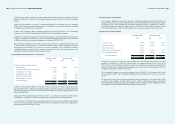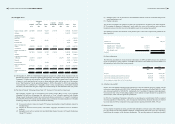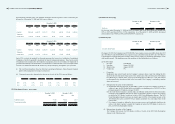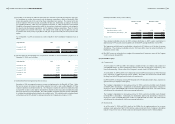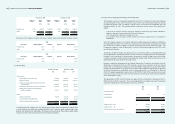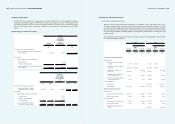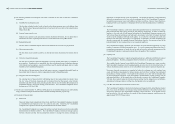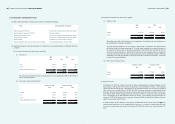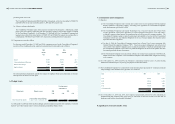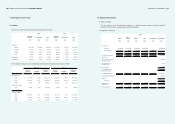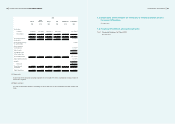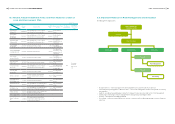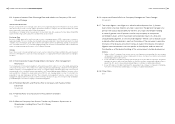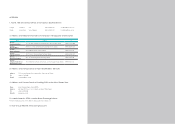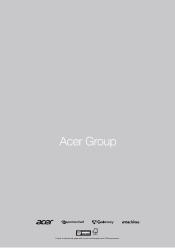Acer 2010 Annual Report Download - page 62
Download and view the complete annual report
Please find page 62 of the 2010 Acer annual report below. You can navigate through the pages in the report by either clicking on the pages listed below, or by using the keyword search tool below to find specific information within the annual report.
ACER INCORPORATED
2010 ANNUAL REPORT
120
FINANCIAL STANDING
121
(b) The following methods and assumptions were used to estimate the fair value of each class of nancial
instruments:
(i) Available-for-sale nancial assets
The fair value of publicly traded stocks is based on the closing quotation price at the balance sheet
date. The fair value of open-end mutual funds is based on the net asset value of the mutual funds at
balance sheet date.
(ii) Financial assets carried at cost
Financial assets carried at cost represent investments in privately held stock. It is not practicable to
estimate the fair value of privately held stock as it is not traded in an active public market.
(iii) Refundable deposits
The fair values of refundable deposits with no xed maturities are based on carrying amounts.
(iv) Non-current receivables
The fair values of non-current receivables are their present value discounted at the market interest
rate.
(v) Derivative nancial instruments
The fair value of derivative nancial instruments is based on quoted market prices, if available, in
active markets. If market price is unavailable, fair value is determined using a valuation technique,
with estimates and assumptions consistent with those used by market participants and are readily
available to the Consolidated Companies.
The fair value of foreign currency forward and option contracts is computed individually based on
the maturity date, the spot rate, and the swap points provided by Bloomberg quotes.
(vi) Long-term debt and bonds payable
The carrying value of long-term debt with oating interest rates approximates the market value.
The fair value of fixed-rate long-term debt is estimated based on the present value of future
discounted cash ows based on the prevailing market interest rates for similar debt instruments of
comparable maturities and credit standing of the borrower. The Consolidated Companies used a
discount rate of 2.11% to 5.09%.
(c) For the years ended December 31, 2009 and 2010, gain (loss) on valuation nancial assets and liabilities
using a valuation technique amounted to NT$1,293,844 and NT$(1,899,825), respectively.
(d) Disclosure of nancial risks
(i) Market risk
Open-end mutual funds and publicly traded stocks held by the Consolidated Companies classied
as “available-for-sale financial assets” are valued at fair value. Therefore, the Consolidated
Companies were exposed to the risk of price uctuation in the securities market.
The Consolidated Companies are engaged in purchase and sale transactions which are principally
denominated in US dollars and Euros. The Consolidated Companies entered into foreign currency
forward contracts and other derivate instrument contracts to manage the market exchange rate
uctuations of foreign-currency assets and liabilities. The length and amounts of aforementioned
derivative transactions were in line with the settlement date of the Consolidated Companies’
recorded foreign currency assets and liabilities and future cash ows. Gains or losses from these
hedging derivatives are expected to substantially offset those from the hedged assets or liabilities.
(ii) Credit risk
The Consolidated Companies’ credit risk is mainly from potential breach of contract by the counter-
party associated with cash, equity investment, and derivative transactions. In order to control its
exposure to the credit risk of each nancial institution, the Consolidated Companies maintain cash
with various financial institutions and hold equity investments in the form of mutual funds and
stocks issued by companies with high credit quality. As a result, the concentration of credit risks
related to cash and equity investments is not signicant. Furthermore, the banks undertaking the
derivative transactions are reputable financial institutions; therefore, the exposure related to the
potential default by those counter-parties is not considered signicant.
The Consolidated Companies primarily sell and market the multi-branded IT products to a large
number of customers in different geographic areas. As a result, management believes that there is
no signicant concentrations of credit risk, and in order to lower the credit risk, management of the
Consolidated Companies continuously evaluate the credit quality of their customers.
(iii) Liquidity risk
The Consolidated Companies’ capital and operating funds are sufficient to fulfill their contract
payment obligations. Therefore, management believes that there is no signicant liquidity risk.
The available-for-sale financial assets held by the Consolidated Companies are equity securities
which are publicly traded and can be liquidated quickly at a price close to the fair market value. In
contrast, the nancial assets carried at cost are not publicly traded and are exposed to liquidity risk.
Derivative financial instruments are intended to hedge the exchange rate risk resulting from
assets and liabilities denominated in foreign currency and cash flows resulting from anticipated
transactions in foreign currency. The length of the contracts are in line with the payment date
of the Consolidated Companies’ assets and liabilities denominated in foreign currency and the
anticipated cash ows. At the maturity date of the derivative contract, the Consolidated Companies
will settle these contracts using the foreign currencies arising from the hedged assets and liabilities
denominated in foreign currency, and therefore, the liquidity risk is not signicant.
(iv) Cash ow risk related to the uctuation of interest rates
The Consolidated Companies’ short-term borrowings and long-term debt carried oating interest
rates. As a result, the effective rate changes along with the uctuation of the market interest rates
and thereby influences the Consolidated Companies’ future cash flow. If the market interest
rate increases by 1%, cash outflows in respect of these interest payments would increase by
approximately NT$139,736 per annum.


